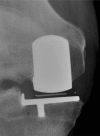Ten-year clinical and radiographic results of 1000 cementless Oxford unicompartmental knee replacements
- PMID: 31209540
- PMCID: PMC7176592
- DOI: 10.1007/s00167-019-05544-w
Ten-year clinical and radiographic results of 1000 cementless Oxford unicompartmental knee replacements
Abstract
Purpose: Unicompartmental knee replacement (UKR) has substantial benefits over total knee replacement (TKR) but has higher revision rates. The cementless Oxford UKR was introduced to address this but there are concerns about fixation and tibial plateau fractures. The first long-term study of the device with clinical and radiographic outcomes is reported.
Methods: The first 1000 medial cementless Oxford UKR were prospectively identified and followed up by independent physiotherapists. Survival was calculated using the endpoints reoperation, revision, revision to TKR, major revision requiring revision TKR components and patient mortality. The Oxford Knee Score (OKS), Tegner Activity Score and American Knee Society Score (AKSS) were recorded and radiographs analysed.
Results: The ten year survival was 96.6% (CI 94.8-97.8), 97.5% (CI 95.7-98.5), 98.9% (CI 97.7-99.4) and 99.6% (CI 98.8-99.9) using reoperation, revision, revision to TKR and major revision as the endpoint, respectively. Commonest causes for revision were bearing dislocation (n = 7, 0.7%), disease progression (n = 4, 0.4%) and pain (n = 2, 0.2%). There was one lateral tibial plateau fracture and one femoral component loosening. At 10 years, the mean OKS was 41.2 (SD 9.8), Tegner 2.8 (SD 1.3), AKSS-O 89.1 (SD 13.0) and AKSS-F 80.4 (SD 14.6). There were no pathological radiolucencies or complete radiolucent lines. There were no implant-related deaths.
Conclusions: The cementless Oxford UKR is a safe procedure with excellent long-term clinical results. Our results suggest that reliable fixation was achieved with only one (0.1%) revision for loosening (femoral), no radiographic evidence of loosening in the remaining cases and no fractures related to implantation.
Level of evidence: III.
Keywords: Cementless fixation; Long-term outcomes; Unicompartmental knee replacement.
Conflict of interest statement
Hasan R Mohammad: Henni Mester Scholarship from University of Oxford and Institutional grant to University of Oxford from Zimmer Biomet; Christopher Dodd: Royalties, consultancy payments related to knee replacements—Zimmer Biomet; James Kennedy: Institutional grant—Grant to University of Oxford from Zimmer Biomet; David Murray: Royalties, consultancy payments related to knee replacements—Zimmer Biomet and Institutional grant—To University of Oxford from Zimmer Biomet. Andrew Judge and Stephen Mellon have no potential conflict of interest.
Figures
Similar articles
-
Ten-year survival and seven-year functional results of cementless Oxford unicompartmental knee replacement: A prospective consecutive series of our first 1000 cases.Knee. 2018 Dec;25(6):1231-1237. doi: 10.1016/j.knee.2018.07.012. Epub 2018 Aug 24. Knee. 2018. PMID: 30150067
-
Five-year experience of cementless Oxford unicompartmental knee replacement.Knee Surg Sports Traumatol Arthrosc. 2017 Mar;25(3):694-702. doi: 10.1007/s00167-015-3879-y. Epub 2015 Nov 26. Knee Surg Sports Traumatol Arthrosc. 2017. PMID: 26611902
-
Cementless medial Oxford unicompartmental knee replacement. Five-year results from an independent series.Knee. 2020 Aug;27(4):1219-1227. doi: 10.1016/j.knee.2020.05.009. Epub 2020 Jun 26. Knee. 2020. PMID: 32711885
-
Cementless unicompartmental knee replacement achieves better ten-year clinical outcomes than cemented: a systematic review.Knee Surg Sports Traumatol Arthrosc. 2021 Oct;29(10):3229-3245. doi: 10.1007/s00167-020-06091-5. Epub 2020 Jul 1. Knee Surg Sports Traumatol Arthrosc. 2021. PMID: 32613336
-
Cemented versus cementless Oxford unicompartmental knee arthroplasty for the treatment of medial knee osteoarthritis: an updated systematic review and meta-analysis.Arch Orthop Trauma Surg. 2024 Sep;144(9):4391-4403. doi: 10.1007/s00402-024-05539-4. Epub 2024 Sep 19. Arch Orthop Trauma Surg. 2024. PMID: 39294529
Cited by
-
[Successful medial unicompartmental knee arthroplasty-What are the most important surgical tricks?].Orthopadie (Heidelb). 2024 Apr;53(4):265-274. doi: 10.1007/s00132-024-04479-6. Epub 2024 Mar 5. Orthopadie (Heidelb). 2024. PMID: 38441567 Review. German.
-
Hybrid Oxford unicompartmental knee arthroplasty has lower residual cement extrusion than cemented arthroplasty in treating end-stage unicompartmental knee osteoarthritis.BMC Musculoskelet Disord. 2021 Sep 29;22(1):833. doi: 10.1186/s12891-021-04720-9. BMC Musculoskelet Disord. 2021. PMID: 34587940 Free PMC article.
-
Physical Activity of Young Patients following Minimally Invasive Lateral Unicompartmental Knee Replacement.J Clin Med. 2023 Jan 12;12(2):635. doi: 10.3390/jcm12020635. J Clin Med. 2023. PMID: 36675564 Free PMC article.
-
A matched comparison of cementless unicompartmental and total knee replacement outcomes based on the National Joint Registry for England, Wales, Northern Ireland and the Isle of Man.Acta Orthop. 2022 May 24;93:478-487. doi: 10.2340/17453674.2022.2743. Acta Orthop. 2022. PMID: 35611477 Free PMC article.
-
Cementless versus cemented unicompartmental knee arthroplasty: a systematic review of comparative studies.Musculoskelet Surg. 2023 Sep;107(3):255-267. doi: 10.1007/s12306-023-00773-2. Epub 2023 Jan 23. Musculoskelet Surg. 2023. PMID: 36689086
References
-
- Australian Orthopaedic Association (2018) Australian Orthopaedic Association: National Joint Replacement Registry (AOANJRR). 2018 Annual Report. Hip, Knee and Shoulder Arthroplasty September 1999–December 2017. https://aoanjrr.sahmri.com/documents/10180/576950/Hip%2C%20Knee%20%26%20.... Accessed 14 June 2019
-
- Campi S, Pandit H, Hooper G, Snell D, Jenkins C, Dodd C, et al. Ten-year survival and seven-year functional results of cementless Oxford unicompartmental knee replacement: a prospective consecutive series of our first 1000 cases. Knee. 2018;25(6):1231–1237. doi: 10.1016/j.knee.2018.07.012. - DOI - PubMed
MeSH terms
LinkOut - more resources
Full Text Sources
Medical
Research Materials





